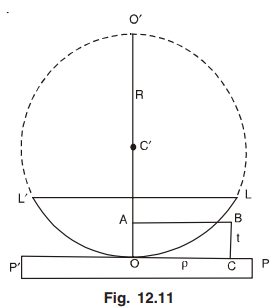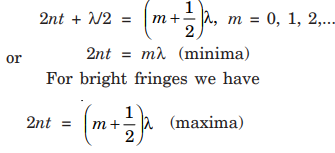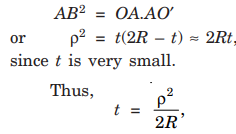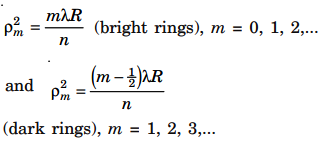
Let LOL′ be the convex surface of a lens in contact with the plane surface PP′ (Fig. 12.11). O is the point of contact. A liquid of refractive index n is placed between the glass plate and the lens. The point where the lens touches the glass plate, the thickness of the film is zero. The thickness of the film increases all around this point as we move away from O. The thin film of liquid thus enclosed is wedge shaped, and the loci of all points having the same thickness are circles. When monochromatic light is made to fall normally on such a film, a series of concentric bright and dark rings are visible all round the point of contact, both in the reflected and in the transmitted rays.
Let C be a point on PP′ at a distance ρ from the point of contact. The thickness of the film at C is CB = t. Thus, the path difference between the two reflected rays at this position is (2nt + λ/2) for normal incidence (see problem 28). So at this position of the film there will be a dark fringe when

Let C′ be the centre of the spherical surface LOL′, having radius of curvature equal to R (Fig. 12.11). We have

The conditions for dark and bright fringes are

for the mth dark ring, m = 0, 1, 2,...

for the mth bright ring, m = 1, 2, 3,...
where ρm is the radius of the mth ring.
Newton’* rings may be obtained with the transmitted light also. In that case the ring system will be complimentary to the reflected one. The central spot will be bright in the transmitted system. For the transmitted light we have
